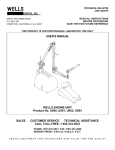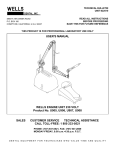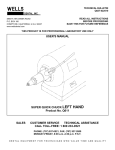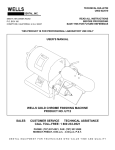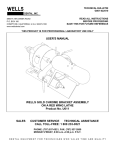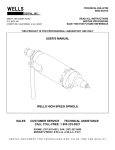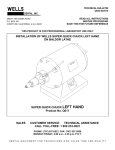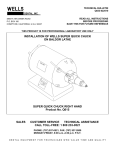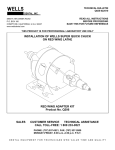Download Electrical Service Manual for Wells Engine Unit
Transcript
TECHNICAL BULLETIN U805-022510 DENTAL, INC. 5860 FLYNN CREEK ROAD P.O. BOX 106 COMPTCHE, CALIFORNIA, U.S.A. 95427 READ ALL INSTRUCTIONS BEFORE PROCEEDING SAVE THIS FOR FUTURE REFERENCE THIS PRODUCT IS FOR PROFESSIONAL LABORATORY USE ONLY ELECTRICAL SERVICE MANUAL WELLS ENGINE UNIT Product No. U900, U901, U903, U904 and U911 SALES CUSTOMER SERVICE TECHNICAL ASSISTANCE CALL TOLL-FREE: 1 800 233-0521 PHONE: (707) 937-0521, FAX: (707) 937-2809 MONDAY-FRIDAY, 8:00 a.m.-4:30 p.m. P.S.T. DENTAL EQUIPMENT FOR TECHNICIANS WHO VALUE TIME AND QUALITY TABLE OF CONTENTS 1.0 2.0 3.0 4.0 5.0 6.0 7.0 8.0 9.0 10.0 INTRODUCTION ........................................................................... 1 SAFETY INSTRUCTIONS ............................................................ 1 TROUBLE SHOOTING ................................................................. 3 SERVICING THE ELECTRICAL SYSTEM ................................... 4 MOTOR BRUSH MAINTENANCE ................................................ 5 REPLACING THE SIX PRONG MALE CONNECTOR ................. 7 REPLACING THE MOTOR ........................................................... 8 REPLACING THE SEMICONDUCTOR OR CIRCUIT BOARD .. 10 REPLACING THE REVERSING SWITCH .................................. 11 ADJUSTING THE TRIMMER ...................................................... 12 1.0 INTRODUCTION IMPORTANT! READ THIS FIRST: Each electrical component of the WELLS Engine Unit depends on the proper functioning of all other electrical components. The failure of a component is very often caused by the malfunction of another part of the electrical system. It is essential to check the entire electrical system according to the procedures of this manual to ensure the reliability of any repair or replacement. A very common error is to replace the Foot Control circuit board or semiconductor without finding the cause for the failure. The Engine Unit will run fine at first but a repeated short circuit elsewhere will eventually cause a failure of the new semiconductor. This manual provides step by step procedures for diagnosing problems and servicing the electrical components of the WELLS Engine Unit. Following the procedures should reduce the chances of electrical failures, equipment down time and unnecessary service bills. Refer to the User's Manual for the WELLS Engine Unit, Technical Bulletin U801 (or U803) for operation, mechanical maintenance and replacement parts list. If you have any difficulties or questions, please call our toll free number, 1 800 233-0521. 2.0 SAFETY INSTRUCTIONS WARNING: WHEN USING ELECTRIC TOOLS, BASIC SAFETY PRECAUTIONS SHOULD ALWAYS BE FOLLOWED TO REDUCE THE RISK OF FIRE, ELECTRIC SHOCK, AND PERSONAL INJURY INCLUDING THE FOLLOWING ITEMS: 1.1 DISCONNECT THE POWER CORD. Unplug the power cord to prevent unintentional starting or electric shock before servicing electrical components, removing the motor base or Foot Control base cover. 1.2 ALWAYS USE SAFETY GLASSES. Wear industrial certified safety glasses for ALL work and maintenance. 1.3 GROUND THE DEVICE. This machine must be grounded while in use to protect the user from electric shock. Plug into a three-hole grounded receptacle. If an adapter is used to accommodate a two-hole receptacle, the grounding lug must be connected to a known ground. Never remove the third prong. If in doubt, have a licensed electrician check the receptacle for PROPER GROUNDING and POLARITY. 1.4 ELECTRICAL MAINTENANCE TO BE DONE BY QUALIFIED PERSONNEL ONLY. ELECTRICAL SERVICE MANUAL for WELLS ENGINE UNIT PAGE 3 3.0 TROUBLE SHOOTING 3.1 3.1.1 3.1.2 3.1.3 MOTOR DOES NOT RUN WHEN THE PEDAL IS PRESSED TO THE FLOOR. Check that the power cord is connected to a live receptical. Check the receptical with a lamp or other electrical appliance to confirm the power is on. Check that the 6 prong connector is securely fastened at the Foot Control. Disconnect the power cord. Replace the fuse in the foot control. You may order Wells part number F109 FUSE 5 AMP PKG-2. Use a type 3AG normal blow 250 volt 5 amp cartridge fuse ONLY. Connect the power cord to a grounded receptical. If the motor still does not run when the pedal is pressed or the fuse blows a second time, go to section 4.0 SERVICING THE ELECTRICAL SYSTEM. 3.2 3.2.1 THE MOTOR RUNS FINE FOR A PERIOD AND THEN INTERMITTENTLY QUITS. The 6 prong connector at the Foot Control may have a bad connection. Go to section 4.0 SERVICING THE ELECTRICAL SYSTEM. 3.3 3.3.1 THE MOTOR SPUTTERS OR POPS. The brushes are worn out. Go to section 5.0 MOTOR BRUSH MAINTENANCE to replace the brushes. 3.4 MOTOR RUNS AT FULL SPEED WHEN THE PEDAL IS SLIGHTLY PRESSED OR NOT PRESSED AT ALL. The semiconductor circuit has failed. Go to section 4.0 SERVICING THE ELECTRICAL SYSTEM to determine the cause for failure. F208 SEMICONDUCTOR KIT may be ordered if the circuit board is in good condition. Otherwise F200 CIRCUIT BOARD KIT may be ordered. After the probable cause of failure is determined, Go to section 8.0 REPLACING THE SEMICONDUCTOR OR CIRCUIT BOARD. 3.4.1 3.5 3.5.1 3.5.2 MOTOR JUMPS OR IS ERRATIC WHEN THE PEDAL POSITION IS SMOOTHLY CHANGED. Check the motor brushes. Go to section 5.0 MOTOR BRUSH MAINTENANCE. The circuit board position may be out of adjustment, the mounting screws may be loose or the wiper arm may be bent. Go to paragraph 4.3 CHECK THE WIPER ARM PRESSURE and 4.4 CHECK THE CIRCUIT BOARD POSITION. 3.6 3.6.1 3.6.2 MOTOR HAS LESS POWER (OR TOP SPEED) THAN BEFORE. Check the motor brushes. Go to section 5.0 MOTOR BRUSH MAINTENANCE. The circuit board position may be out of adjustment, the mounting screws may be loose or the wiper arm may be bent. Go to paragraph 4.3 CHECK THE WIPER ARM PRESSURE and 4.4 CHECK THE CIRCUIT BOARD POSITION. If the brushes are in good condition, the wiper arm is adjusted correctly but the motor is fairly old, the commutator may be worn out. Go to section 7.0 REPLACING THE MOTOR. 3.6.3 3.7 3.7.1 3.7.2 MOTOR MAKES EXCESSIVE WHINING NOISE MORE THAN BEFORE. Check the motor brushes. Go to section 5.0 MOTOR BRUSH MAINTENANCE. If the brushes are in good condition, the noise may be from bad motor bearings. Disconnect the power cord, remove the belt and turn the motor pulley by hand. If the shaft does not turn smoothly, the motor bearings are bad. Replace the whole motor since the commutator is probably worn out also. Go to section 7.0 REPLACING THE MOTOR. 3.8 3.8.1 MOTOR SPEED CHANGES BY ITSELF WHEN THE PEDAL IS HELD STEADY. The line voltage has increased or decreased. This usually happens when another electrical device on the circuit such as a motor turns on or off. This is especially pronounced when wiring circuits are overloaded. Provide a circuit with adequate capacity for its use. U805-022510 WELLS DENTAL, INC. ELECTRICAL SERVICE MANUAL for WELLS ENGINE UNIT 3.9 3.9.1 PAGE 4 THE HANDPIECE RUNS BACKWARDS The belt has probably been installed incorrectly. Refer to the User's Manual for the Wells Engine Unit, page 5, paragraph 4.2. CHECK FOR CORRECT ROTATION and step 4.1.6 for installing the belt. 3.10 MOTOR RUNS IN REVERSE BUT NOT FORWARD. 3.10.1 If the Foot Control is old, the pedal and base may be worn out. The parts in the pivot will eventually become loose so the reversing switch will not work. The Foot Control can be sent in for repair. 3.10.2 If the Foot Control is not very old and the pivot is not loose, the reversing switch may be bad. Go to section 9.0 REPLACING THE REVERSING SWITCH. 3.11 THE SLOWEST SPEED IS NOT SLOW ENOUGH. 3.11.1 Go to paragraph 10.0 ADJUSTING THE TRIMMER. 3.12 THE SLOWEST SPEED IS TOO SLOW. 3.12.1 Go to paragraph 10.0 ADJUSTING THE TRIMMER. 3.13 MOTOR DOES NOT START UNTIL THE PEDAL IS HALFWAY TO THE FLOOR. 3.13.1 The circuit board position may be out of adjustment, the mounting screws may be loose or the wiper arm may be bent. Go to paragraph 4.3 CHECK THE WIPER ARM PRESSURE and 4.4 CHECK THE CIRCUIT BOARD POSITION. 3.14 THE ENGINE UNIT CAUSES STATIC ON THE RADIO OR TV. 3.14.1 All brush type motors will cause static because of the arcing of the brushes. The distance to the radio (TV), its filtering capabilities and the condition of the motor brushes and commutator are all factors in the amount of the static. Replacing the motor brushes may help but if the motor is very old, the commutator is worn causing more static. A new motor may reduce the static. Go to paragraph 7.0 REPLACING THE MOTOR. 4.0 SERVICING THE ELECTRICAL SYSTEM 4.1 4.1.1 4.1.2 4.1.3 4.2 4.2.1 4.2.2 4.2.3 4.2.4 U805-022510 INSPECT THE CORDS Unplug the power cord. Examine the entire length of both electrical cords for pinched, cut or abraded areas. Replace the cords if damaged. Examine the power plug. Replace the plug or entire power cord if damaged or if the grounding lug has been removed. INSPECT 6 PRONG FEMALE CONNECTOR A short in the 6 prong female connector on the end of the cord from the Hood & Motor is a prime cause for semiconductor circuit failure. The connector must be disassembled for inspection. Unplug the connector from the Foot Control. Loosen the strain relief clamp screws on the connector. See Figure 1. Push out the small pin in the connector with an awl or small diameter tool. Figure 1. 6 Prong Female Connector Pull back the cover and examine the connections carefully. Make sure that the terminals are not bent and are separated by at least 1/8". Any loose or frayed connections must be re-soldered. Replace the cover and pin. Replace the connector if cracked or broken. WELLS DENTAL, INC. ELECTRICAL SERVICE MANUAL for WELLS ENGINE UNIT PAGE 5 4.3 4.3.1 4.3.2 CHECK THE WIPER ARM PRESSURE Remove the four rubber feet on the bottom of the Foot Control and lift off the base cover. The wiper arm should always press firmly on the contact pins. See Figure 4. on page 7. If it is loose, the circuit board should be replaced. (Removing the phenolic arm and twisting the brass crank pin to bend the wiper arm toward the contact pins may help as a interim measure. This procedure is not encouraged because the wiper arm could be ruined. Also, the loose wiper arm is a symptom of a worn out circuit board.) 4.4 4.4.1 CHECK THE CIRCUIT BOARD POSTION The wiper arm should swing from an OFF position, over the contact pins, to a full ON position in both forward and reverse. This position can be adjusted by loosening the mounting screws and moving the circuit board. See Figure 4. on page 7. Put the pedal in its forward position. Depress the pedal to its full ON position and check if the wiper arm is riding on the wire bridge. Let the pedal return to its OFF position. The edge of the wiper arm should be just touching the stop or within 1/16" from it. If not, loosen the mounting screws and adjust the circuit board position so it is. Tighten the mounting screws, depress and release the pedal again and check the wiper arm position. If it is within 1/16" from the stop or barely touching it, the circuit board it correctly positioned. Make sure the mounting screws are snug. 4.4.2 4.4.3 4.5 4.5.1 4.5.2 4.5.3 INSPECT THE FOOT CONTROL WIRING Examine the 6 prong male connector. Replace if cracked or broken. Carefully inspect each connection. Wiggle each wire to confirm that it is secure. Any loose or frayed wire must be re-soldered. Replace the base cover and four rubber feet. Plug the 6 prong connector securely and snap the wire plug retainer into place. Continue with the next section ... 5.0 MOTOR BRUSH MAINTENANCE Motor brushes need to be replaced periodically. Brush life depends on the amount and type of use as well as the age of the motor and other factors. Typical brush life for large brush motors is nine months to over a year when used continuously (40 hrs per week). Typical brush life for small brush motors is five to seven months when used continuously. Inspect the brushes periodically to detect worn out brushes which can cause erratic motor operation and damage to the commutator. 5.1 5.1.1 5.1.2 5.1.3 5.1.4 5.1.5 U805-022510 REMOVE THE HOOD Unplug the power cord. Remove the belt and arm assembly from the hood. Remove the pulley guard. Remove the motor pulley after loosening the set screw with the 3/32" hex wrench. Turn the hood & motor upside down and remove the four rubber feet. Do not remove the four pan head screws in the center of the motor base. Carefully turn the hood & motor right side up and set it on a bench. Slowly lift the hood and note how the wires are routed around the motor so they do not touch the shaft. Lay the hood on its side next to the motor. Do not remove any of the wires. Figure 2. Hood & Motor WELLS DENTAL, INC. ELECTRICAL SERVICE MANUAL for WELLS ENGINE UNIT 5.2 5.2.1 5.2.2 5.3 5.3.1 5.3.2 5.3.3 PAGE 6 INSPECT THE MOTOR WIRING Examine the entire length of each wire for pinched, cut or abraded areas. Repair or replace any damaged wires. Carefully inspect each connection. Wiggle each wire to confirm that it is secure. Any loose or frayed wire must be repaired. INSPECT THE BRUSHES Remove both brush caps and brushes. The brushes will stop working when they are about 1/4" long. If the length of the carbon brushes is less than 3/8" or the brushes are unequal lengths, replace BOTH brushes as a set. New units are shipped with a set of replacement brushes in the accessory kit. If you need to order brushes, the product number is usually found printed on the motor base. If not, determine which motor you have: Large Brush Bodine Motor The brush caps protrude about 1/2" from the motor housing. (Found in all 115 volt units manufactured since 1987.) Order E105 BRUSHES BODINE LARGE PKG-2. Small Brush Bodine Motor The brush caps are recessed into the motor housing so they are flush. (Found in all 115 volt units manufactured between 1983 and 1987 and in all 230 volt units.) Order E107 BRUSHES BODINE SMALL PKG-2. WSM Motor The label on the motor housing states WSM. (Found in units manufactured before 1983.) Order E106 BRUSHES WSM MOTOR PKG-2. BALDOR MOTOR Brush for E026, E027, E028, E029. Order E101 BRUSHES BALDOR MOTOR PKG-2 Also, compare your brushes with those illustrated in Figure 3. below: 5.3.4 5.3.5 5.3.6 5.3.7 U805-022510 Install the brushes making sure that they slide freely and make contact with the commutator. Do not over tighten the caps. (If installing E106 brushes, make sure the curved end of the brush matches the curve of the commutator.) Place the hood over the motor routing the wires around the base of the motor. CAUTION: Take extreme care that the wires do not lay on the motor shaft or get pinched under the hood. Fasten the four rubber feet, install the pulley, pulley guard, arm assembly and belt. Adjust the belt tension. Refer to the User's Manual for Wells Engine Unit. If the motor will not run after replacing the brushes, disconnect the power cord and replace the fuse in the foot control. You may order Wells part number F109 FUSE 5 AMP PKG-2. Use a type 3AG normal blow 250 volt 5 amp cartridge fuse ONLY. WELLS DENTAL, INC. ELECTRICAL SERVICE MANUAL for WELLS ENGINE UNIT PAGE 7 6.0 REPLACING THE SIX PRONG MALE CONNECTOR The F202 CONNECTOR 6 PRONG MALE KIT is for replacement of the six prong plug on the back of the WELLS FOOT CONTROL, product numbers F011, F013, F015 and F017. Figure 4. Foot Control Components 6.1 6.1.1 6.1.2 6.1.3 6.1.4 6.1.5 6.1.6 6.1.7 6.1.8 Figure 5. Foot Control Wiring Diagram DISASSEMBLY Unplug the power cord. Disconnect the 6 prong female connector from the foot control. Remove the four rubber feet from the bottom of the foot control and lift off the base cover. Fold back the paper insulation cover. Disconnect the white wire at the fuse holder. See Figure 5. (If the foot control does not have a fuse, unsolder the white wire from the terminal on the 6 prong connector. See Figure 6.) Note to which terminals the red, brown and black wires are connected at the reversing switch and disconnect them. Remove the two screws that hold the 6 prong connector and the plug retainer. Note how the wires from the 6 prong connector are routed behind the heat sink (brass bracket). Remove the 6 prong connector. Figure 6. No Fuse U805-022510 WELLS DENTAL, INC. ELECTRICAL SERVICE MANUAL for WELLS ENGINE UNIT 6.2 6.2.1 6.2.2 6.2.3 6.2.4 6.2.5 6.2.6 6.2.7 6.3 PAGE 8 ASSEMBLY Install the new 6 prong connector routing the wires behind the heat sink (the brass bracket). Attach the plug retainer and 6 prong connector with the two screws. Older models have nuts for the screws. Use needle nose pliers to hold the nuts while tightening the screws. Connect the red, brown and black wires to the correct terminals on the reversing switch. See Figure 5. Connect the white wire to the terminal on the end of the fuse holder. Make sure the white wires are connected to the fuse holder as illustrated in Figure 5. If the foot control does not have a fuse, unsolder the white wire with the connector from the new 6 prong connector. Solder the white wire from the triac to the terminal on the 6 prong connector. See Figure 6. A short circuit in any of the connections may cause a semiconductor failure. Be sure to check each wire from its connection along its whole length to make sure that the bare areas and terminals are separated by a gap of at least 1/16". Check all the connections at the six prong plug. Check the leads on the triac and the semiconductor circuit. Check all the connections and jumpers at the reversing switch. Check the connections at the trimmer. After confirming the circuits are correct, fold down the paper insulation cover. Place the base cover so the hole allows access to the trimmer and fasten the four rubber feet. INSPECT THE OTHER COMPONENTS Before putting the Engine Unit back into service, a careful check of the other components must be made. Go to section 4.0 SERVICING THE ELECTRICAL SYSTEM if you have not already done so. The installation of the 6 prong male connector is now complete. If you have any difficulties or questions, please call WELLS DENTAL, INC. at 1-800-233-0521. 7.0 REPLACING THE MOTOR The following motors are available for replacement: E131 BODINE MOTOR 115V LARGE BRUSH E129 BODINE MOTOR 115V SMALL BRUSH (E129 replaces the WSM motor) E130 BODINE MOTOR 230V SMALL BRUSH Measure the width of the handle of the hood (See Figure 7). If the handle is about 1-1/8" wide, only a small brush motor E129 or E130 will fit. If the handle is about 3/4" wide, any of the motors above will fit. 7.1 7.1.1 7.1.2 7.1.3 7.1.4 7.1.5 U805-022510 REMOVE THE HOOD Unplug the power cord. Remove the belt and arm assembly from the hood. Remove the pulley guard. Remove the motor pulley after loosening the set screw with the 3/32" hex wrench. Turn the hood & motor upside down and remove the four rubber feet. Do not remove the four pan head screws in the center of the motor base. Carefully turn the hood & motor right side up and set it on a bench. Slowly lift the hood and note how the wires are routed around the motor so they do not touch the shaft. Lay the hood on its side next to the motor. Figure 7. Hood & Motor WELLS DENTAL, INC. ELECTRICAL SERVICE MANUAL for WELLS ENGINE UNIT 7.2 7.2.1 7.2.2 7.2.3 7.2.4 7.2.5 PAGE 9 REMOVE THE MOTOR Examine the five wire connectors. Note that one wire connector connects a black cord wire to a white cord wire. Do not cut these wires. See Figure 8. Cut the four motor wires. (Red, black, yellow and brown or orange) Disconnect the green ground wire on the motor frame. Remove the four pan head screws holding the motor to the base. If there is a 2" x 2" mounting plate with four flat head screws attached to the motor, remove it. Figure 8. Wiring diagram for Hood & Motor 7.3 7.3.1 7.3.2 7.3.3 7.3.4 INSTALL THE NEW MOTOR If there was a 2" x 2" mounting plate, attach it to the new motor with the four flat head screws. Position the mounting plate so that six of its eight holes align with the six holes in the motor. Attach the motor to the motor base with the four pan head screws. Tighten these screws only enough to begin to smash the grommet. Do not over tighten. Strip the cord wires inside the hood 1/4" from the end. (Black, brown, red and white) Connect the four motor wires with the wire connectors that came with the motor using a wire crimp tool. See Figure 8. Red motor wire to black cord wire Black motor wire to brown or orange cord wire Yellow motor wire to red cord wire Brown motor wire to white cord wire 7.3.5 7.3.6 7.3.7 7.3.8 7.3.9 Connect the green wire to the motor frame. Wrap the wires around the base of the motor as was noted in step 7.1.5. CAUTION: Take extreme care that the wires do not lay on the motor shaft or get pinched under the hood. Fasten the four rubber feet, install the pulley, pulley guard, arm assembly and belt. Adjust the belt tension. Refer to the User's Manual for Wells Engine Unit. Before putting the Engine Unit back into service, a careful check of the other components must be made. Go to section 4.0 SERVICING THE ELECTRICAL SYSTEM if you have not already done so. Go to section 10.0 ADJUSTING THE TRIMMER The installation of the motor is now complete. If you have any difficulties or questions, please call WELLS DENTAL, INC. at 1-800-233-0521. U805-022510 WELLS DENTAL, INC. ELECTRICAL SERVICE MANUAL for WELLS ENGINE UNIT PAGE 10 8.0 REPLACING THE SEMICONDUCTOR OR CIRCUIT BOARD The F208 SEMICONDUCTOR KIT is for replacement of the semiconductor circuit only. The F200 CIRCUIT BOARD KIT is for replacement of the whole circuit board in the WELLS FOOT CONTROL, product numbers F011 and F015. 8.1 8.1.1 8.1.2 8.1.3 8.1.4 8.1.5 REMOVE THE CIRCUIT BOARD Unplug the power cord. Unplug the 6 prong connector at the foot control. Remove the four rubber feet from the bottom of the Foot Control and lift off the base cover. Fold back the paper insulation cover. Remove the flat head and the round head screws that hold the curved phenolic arm. See Figure 4. on page 7. Remove the phenolic arm. 8.1.6 Remove the return spring. 8.1.7 Disconnect the white wire from the reversing switch. 8.1.8 Disconnect the white wire that connects the triac to the fuse holder. See Figure 5. (If the foot control does not have a fuse, unsolder the white wire at the terminal on the 6 prong connector. See Figure 6.) 8.1.9 Remove the two mounting screws that hold the plastic circuit board and remove the circuit board. 8.1.10 If you are installing the whole circuit board, skip paragraph 8.2 and go directly to paragraph 8.3. 8.2 8.2.1 8.2.2 8.2.3 8.2.4 8.2.5 8.2.6 8.2.7 8.3 8.3.1 8.3.2 8.3.3 8.3.4 8.3.5 8.3.6 8.3.7 U805-022510 REPLACE THE SEMICONDUCTOR CIRCUIT (unless the whole circuit board is being replaced) Unsolder the black insulated wire that is connected to the trimmer. Note that there is a small blue wire connected to the same terminal. Note the position of the semiconductor circuit before its removal. Using a 9/16" end wrench as a backup, remove the recessed nut that holds the triac with a 7/16" thin wall socket wrench. Remove the semiconductor circuit. Set it aside so it will not get mixed up with the new one. Place the new semiconductor circuit into the circuit board in the same position as the old one. Place the 1/4" star washer on the stud of the triac and start the nut. Using the 9/16" end wrench on the triac for backup, tighten the nut with the 7/16" socket. Wrap the end of the black insulated wire around the trimmer terminal making sure that the small blue wire is still connected. Solder the wires to the terminal using rosin core solder. INSTALL THE CIRCUIT BOARD Fasten the new or repaired circuit board into position with the two mounting screws. The exact position of the circuit board will be adjusted later. Connect the white wire that comes from the triac to the fuse holder. Make sure the white wires are connected to the fuse holder as illustrated in Figure 5. (If the foot control does not have a fuse, cut the connector from the end of the white wire that comes from the triac. Strip the wire 3/16" and solder it to terminal #1 of the 6 prong connector. See Figure 6.) Connect the white wire that comes from the heat sink to the correct terminal on the reversing switch. See Figure 5. Install the return spring. Install the phenolic arm. The flat head screw fastens the larger end of the phenolic arm to the post from the pedal. The small round head screw fastens the smaller end of the phenolic arm to the brass crank pin of the wiper arm. The wiper arm should swing from an OFF position, over the contact pins, to a full ON position in both forward and reverse. Put the pedal in its forward position. Depress the pedal to its full ON position and check if the wiper arm is riding on the wire bridge. See Figure 2. Let the pedal return to its OFF position. The edge of the wiper arm should be just touching the stop or within 1/16" from it. If not, loosen the mounting screws and adjust the circuit board position so it is. Tighten the mounting screws, depress and release the pedal again and check the wiper arm position. If it is within 1/16" from the stop or barely touching it, the circuit board it correctly positioned. Make sure the mounting screws are snug. WELLS DENTAL, INC. ELECTRICAL SERVICE MANUAL for WELLS ENGINE UNIT PAGE 11 8.3.8 A short circuit in any of the connections may cause a semiconductor failure. Be sure to check each wire from its connection along its whole length to make sure that the bare areas and terminals are separated by a gap of at least 1/16". Check all the connections at the 6 prong connector. Check the leads on the triac and the semiconductor circuit. Check all the connections at the reversing switch. Check the connections at the trimmer. 8.3.9 Apply electrical contact grease (Wells lubricant 112) to the contact pins. Apply grease to the forward/reverse locating pin under the pedal. 8.3.10 Fold down the paper insulation cover. Place the base cover so the hole allows access to the trimmer and fasten the four rubber feet. 8.3.11 IMPORTANT! To prevent a semiconductor failure, go to section 4.0 SERVICING THE ELECTRICAL SYSTEM and complete all steps before connecting the Engine Unit to the power source if you have not yet done so. 8.3.12 Go to section 10.0 ADJUSTING THE TRIMMER. The installation of the Semiconductor Kit or Circuit Board Kit is now complete. If you have any questions or problems, please call WELLS DENTAL, INC. at 1-800-233-0521. 9.0 REPLACING THE REVERSING SWITCH F560 REVERSING SWITCH is for replacement of the reversing switch in the WELLS FOOT CONTROL, product numbers, F011 and F013. 9.1 9.1.1 9.1.2 9.1.3 9.1.4 9.1.5 9.1.6 9.1.7 9.2 9.2.1 9.2.2 9.2.3 9.2.4 9.2.5 9.2.6 REMOVE THE REVERSING SWITCH Unplug the power cord. Unplug the 6 prong connector at the foot control. Remove the four rubber feet from the bottom of the Foot Control and lift off the base cover. Fold back the paper insulation cover. Remove the flat head and the round head screws that hold the curved phenolic arm. See Figure 4 on page 7. Remove the phenolic arm. Note the position of the wires on the reversing switch then disconnect them. Loosen the two Phillips head screws and remove the switch. INSTALL THE REVERSING SWITCH Switch the toggle of the new switch toward the side with the lugs. Install the switch so the lugs are toward the edge of the Foot Control base (away from the circuit board). See Figure 4. on page 7. Tighten the Phillips head screws. Connect the wires to the correct lugs. See Figure 5. (or Figure 6.). Install the phenolic arm. The flat head screw fastens the larger end of the phenolic arm to the post from the pedal. The small round head screw fastens the smaller end of the phenolic arm to the brass crank pin of the wiper arm. After confirming the circuits are correct, fold down the paper insulation cover. Place the base cover so the hole allows access to the trimmer and fasten the four rubber feet. Before putting the Engine Unit back into service, a careful check of the other components must be made. Go to section 4.0 SERVICING THE ELECTRICAL SYSTEM if you have not already done so. The installation of the reversing switch is now complete. If you have any difficulties or questions, please call WELLS DENTAL, INC. at 1-800-233-0521. U805-022510 WELLS DENTAL, INC. ELECTRICAL SERVICE MANUAL for WELLS ENGINE UNIT PAGE 12 10.0 ADJUSTING THE TRIMMER 6.0 6.1 U805-022510 SLOW SPEED ADJUSTMENT The slow speed trimmer is adjusted with a small screwdriver through the hole in the base cover. See Figure 9. Place the foot control upside down on a bench. Depress the pedal slowly until the motor just starts rotating. Hold the pedal in this position and turn the trimmer to select the desired speed. Figure 9. Bottom of Foot Control WELLS DENTAL, INC.












